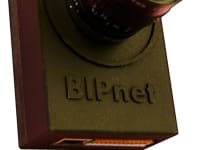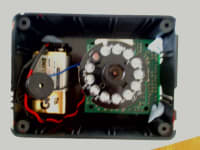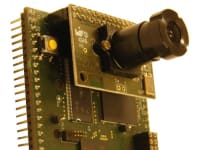
SafeDrive is a smart widget that detects if a car driver is sleeping at the wheel by computing the blinking frequency and face orientation.
The widget has to be placed on the sun visor of the driver by means of a clip and point the camera to the driver's face.
SafeDrive is battery powered and self-contained and works both in day and night conditions.
A high power buzzer wakes up the driver when a sleeping pattern is detected.
There is only a setup step necessary to make sure that when placed the device is detecting the face of the driver.
The device can be recharged via USB or the usual 12V car supply.
The current prototype is shown in Figure 2 whereas a possible product could look like Figure 1 with a wider optic and the additional IR rose.
Sleepiness and driving is a dangerous combination. Most people are aware of the dangers of drinking and driving but don’t realize that drowsy driving can be just as fatal. Like alcohol, sleepiness slows reaction time, decreases awareness, impairs judgment and increases your risk of crashing.
The National Highway Traffic Safety Administration conservatively estimates that 100,000 police-reported crashes are the direct result of driver fatigue each year. This results in an estimated 1,550 deaths, 71,000 injuries, and $12.5 billion in monetary losses. These figures may be the tip of the iceberg, since currently it is difficult to attribute crashes to sleepiness.
There is a visual demonstration of the prototype in the linked video.
I have been working on this project for a while but couldn't find a suitable source of investment to make it commercially available, the retail price can be in the range of the 200 USD.
The current prototype is based on a CMUCam v3 with a very low refresh rate, but the software can be easily ported on a CMUCam v4 or on a BIPEye module as in Figure 3.
The prototype can also contain an accelerometer that detects a car accident and via bluetooth can deliver an alarm through a paired Smart Phone.
We have already developed a separate android application for the impact detection.
Most car manufacturer are developing their own sensors (I know that Toyota is developing one internally) that will be embedded in future luxury cars. However my solution can be retrofitted to all vehicles including cars and trucks.
Truck drivers are probably the most vulnerable ones since they usually do long hauls and thus more sensible to sleepiness.
This device is a life safer assuming that the driver will realize that they should take a rest.
Implementation:
The software implements a different approach, during the day a Viola Jones detector extrapolate the face and then eyes are extracted via Haar features. The blinking rate in combination with the head orientation determines the fatigue of the driver. During the night the blink rate is determined by the bright pupil illumination. The blink rate is correlated to the fatigue via simple and well known physiological function.
Video
-
Awards
-
 2012 Top 100 Entries
2012 Top 100 Entries
Like this entry?
-
About the Entrant
- Name:Paolo Di Prodi
- Type of entry:individual
- Software used for this entry:OpenCV, Linux GNU, CMUCam, ARM cortex tools
- Patent status:none








